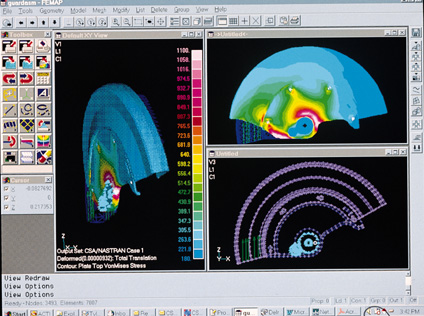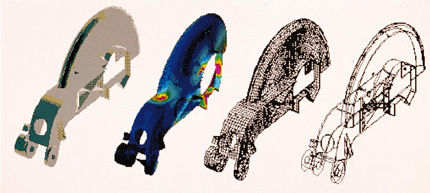Stresses and Strains
More than a step saver, computerized looks at stress, vibration, and acoustical properties of structures can be seen—before prototyping even begins.
NASA software engineers have created thousands of computer programs over the decades. These computer tools can design, test, and analyze a broad assortment of aerospace parts and structures. Considered one of the most successful and widely-used NASA software programs is the NASA Structural Analysis Program, called for short, NASTRAN®.
Originally created by Goddard Space Flight Center for spacecraft design, NASTRAN has been employed in a host of non-aerospace applications. NASTRAN is available to industry through NASA's Computer Software Management and Information Center (COSMIC), located at the University of Georgia.
COSMIC maintains a library of computer programs from NASA and other government agencies and offers them for sale at a fraction of the cost of developing a new program.
Computerized Structural Analysis and Research (CSAR) Corporation, located in Agoura Hills, California, is a leading producer of mechanical computer-aided engineering software. CSAR first released in 1984, an enhanced version of the COSMIC NASTRAN. This finite element analysis (FEA) program is now in use by companies around the world for solving the largest, most difficult engineering problems.
NASTRAN software mathematically analyzes a design and predicts how it will stand up under various stresses and strains. Quick and inexpensive, it minimizes trial and error in the design process and makes possible better, lighter, and safer structures while significantly reducing development time.
Established in 1982, CSAR's goal was providing the best FEA tools available. Products were successfully marketed as CSAR gained a reputation for its unique software products, training and technical support for the engineering community. In 1988, CSAR purchased the COSMIC NASTRAN source code outright, releasing the first "independent" version of the software. All titles, ownership, and proprietary rights to the CSAR's NASTRAN version reside solely with the CSAR Corporation.
"We have concentrated on developing the capabilities that NASTRAN users find most valuable while leap-frogging our competitors with superior speed and cost effectiveness," says R. Swami Narayanaswami, CSAR's President and Chief Executive Officer. For example, CSAR has established software for general purpose nonlinear finite element analysis that can tackle everything from simple large displacement problems to complex phenomena involving impact, structural collapse, and even explosion.
A CSAR just-released software product gives engineers the ability to quickly and easily model the physical characteristics of almost any three-dimensional object, simulate static or dynamic loadings on the object, and calculate the response of the object to those loadings. State-of-the-art numerical algorithms take advantage of the computational abilities of today's high-speed workstations and supercomputers.
In 1997, CSAR celebrated 15 years in business. CSAR literally operated out of a car garage, Narayanaswami notes. He fondly remembers those early years from his office of today, in the 7,000 square foot CSAR complex.
CSAR operates a subsidiary office in London and has ongoing agreements with distributors in Germany, Japan, India, Singapore, Malaysia, and Korea. CSAR enjoys revenues from over 500 leases of NASTRAN-enhanced versions of software for the personal computer on a worldwide basis.
® NASTRAN is a registered trademark of NASA.

Computer software analyzes how a hardware design will stand up under temperature ranges, vibration shocks, and other stressful forces.

CSAR software has gained wide popularity in the engineering community. Software designed by the commercial company to perform structural tests of a component before actually being built evolved from NASA-developed NASTRAN software.













